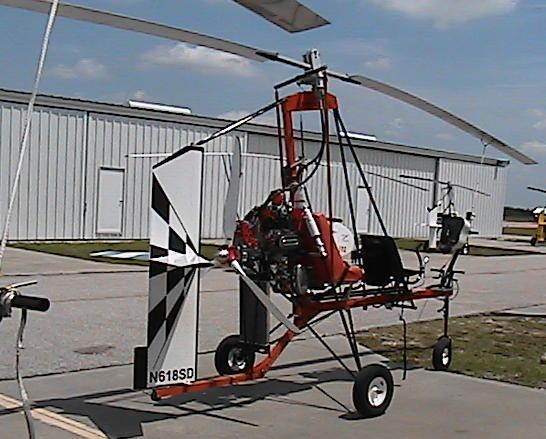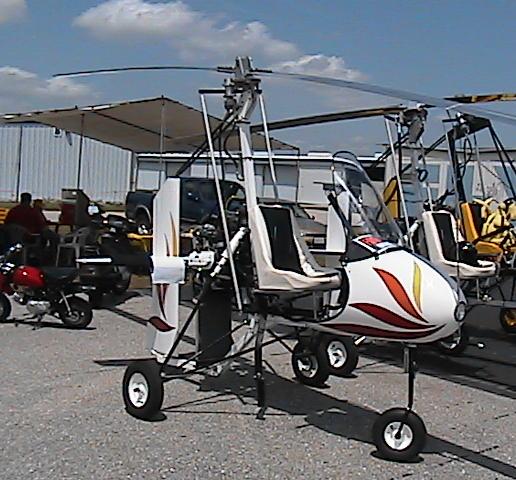|
Aircraft PaintIt doesn't take much to make your gyro stand out from the rest.
We all know what paint is and how it can really change the appearance of anything. Over the years some special primers and paints have been developed to handle the harsh environment that involves flying. The interior structure of a welded tubular airframe should be painted with an anti-corrosion primer called zinc chromate. There are some other epoxy based primers that can be used but zinc chromate (while not an epoxy) is the most common treatment. Zinc chromate comes in yellow or green color. If you have ever seen the inside of an aircraft structure, like a P-51 with the panels off, those green parts are painted with zinc chromate primer. Obviously this primer needs to be applied before any covering is installed. Fiberglass or composite parts suffer from an ultra-violet breakdown if not properly protected and a special primer with U.V. blockers is available for these parts. In aircraft there really is only two choices of types of paint to use. Either enamel or epoxy. Lacquer just does not seem to handle the chemicals and fades too quickly. Enamel is much cheaper and less hazardous than epoxy (polyurethane) paints. There are some problems with enamels when it involves aircraft. Enamel is fairly brittle and does not flex much. This can cause paint to chip off or crack in short order even when plasticizers are added to make the paint more flexible. It also fades and oxidizes after some time even when stored indoors. Enamels will also breakdown when in contact with certain chemicals. Polyurethane paints are flexible, strong and resistant to almost all chemicals and have a wet look appearance even when completely cured. A clear coat is not needed but can add a greater degree of depth to the paint and added protection but is not required to get the paint to shine. It is also expensive and more hazardous to work with than enamel. Just like most things in aviation we have a trade off to deal with. I have seen some builders use enamel for the paint scheme and then put on a coat of polyurethane clear coat for added protection and that super shine. Be aware that you can ruin the paint job if the two brands are not compatible. Some of you may be saying, "well, I'm going to get Imron". You may have hear of Imron paint and it's great color and durablity. Imron is not a type of paint. Imron is a tradename for a brand of polyurethane (epoxy) paint offered by the DuPont Corporation. When a paint brand is decided on stay with that specific manufacturers brands of primers, reducers, and so on. Paint is very much a chemical action and the paint companies spend big dollars for chemists to formulate their paint. This means brand A is not optimal for use with brand B. Don't play junior chemist and you can save yourself a lot of problems and time. Like everything in life we have to consider our budget. When it comes to flexible structures such as composite or fabric covered aircraft I personally prefer polyurethane paints. If adequately taken care of these paints can last through your lifetime. I enjoyed painting our gyroplane but I wasn't keen on doing it every ten to twenty years. You do what you need to get you in the air, enamel or epoxies the choices is yours. The paint supplier can also provide you all the supplementary items you may need. Filters, stir sticks, reducers, cleaners, masks, and painting equipment. Polyurethane paints give off cyanide gas when being sprayed. The paint is safe when in liquid or cured form; the gas is only released when sprayed. If you are unfamiliar with cyanide it is poisonous to people and pets and almost anything with legs, fins, or wings. Special fresh air masks or a suit will be needed to protect you from this poisonous gas. Note: My father said he looked at the purchase of this equipment as a life insurance policy. Not a bad train of thought at all. The dollars spent on protective equipment can certainly outweigh the medical costs and loss of work if you fall victim to this deadly gas. We want to have fun and be safe. Remember: Safe = Fun. You will also need to protect your friends, neighbors, family and pets when painting with any type of paint. If local regulations prevent you from painting you may have to have an approved paint shop do the painting for you. So be sure to check local regulations and be considerate to your neighbors. I painted our gyroplane with polyurethane paint. It was the first time I had ever worked with this product and became aware that spraying each color should be done all at once to ensure the color is correct. If, you paint one area and come back the next day and paint in the same color at the new location you will get a different shade of color. You also have a limited amount of time before the paint "cooks-off". A well planned preparation and plan of how, what and when of things to be done will help things move smoothly. An assistant is of great value to help in preparations, cleaning and the extra set of eyes to look for flaws. Our paint booth was made from PVC pipe and Visquene plastic and duct tape. (I got the idea from a Red and Green show-just kidding) honestly, that was our paint booth, cheap and effective. Most kit or plan instructions will have an aircraft view that can be used for planning your paint scheme. Make some copies and use colored pencils, pens or even crayons to design your scheme. This is something the whole family can contribute to. Wives and kids can be very creative. Of course if you are into computers you can find software that can be used for planning your paint scheme. It is highly recommended that you read plenty of material on aircraft painting before you begin. The knowledge you gain can pay great dividends in the end. You should also check the paint gun set up before going straight to the part. You may need to adjust the flow of the gun or find you need a different nozzle to spray heavy solids primer. Use some old cardboard as your test target. Here is a little checklist to help you. 1. Inform yourself. 2. Select a type of paint/primer. 3. Select a brand of paint/primer. 4. Make copies of the gyroplane side view. All three views if you have them available. 5. Design a paint scheme. 6. Order paint and supplies. 7. Prepare parts in accordance with the paint manufacturers instructions. 8. Prime parts. 9. Watch primer dry. Just Joking. 10. Paint parts. 11. Watch paint dry. I couldn't resist. 12. Show off your beautiful work of art. So put some color on your gyroplane and see it shine. Next step- Landing Gear.
Airtech Coatings Inc.
Parts Logistics is a world leader in supplying quality aircraft parts and hardware across the industry from commercial aircraft applications to the homebuilder. Parts Logistics can provide you with all the parts for your project. Setting up an account is entirely free, so be sure to check them out. They also carry a reputation for having what you are looking for on hand and in stock, which can really be of value if you are concerned about the length of time for your build. |



